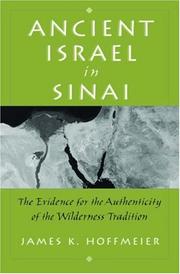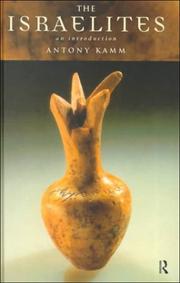| Listing 1 - 10 of 15 | << page >> |
Sort by
|
Book
ISBN: 3631558074 Year: 2006 Publisher: Frankfurt am Main Lang
Abstract | Keywords | Export | Availability | Bookmark
 Loading...
Loading...Choose an application
- Reference Manager
- EndNote
- RefWorks (Direct export to RefWorks)
Moabite stone --- Biblia --- History of Biblical events. --- Israel --- History.

ISBN: 9789004369238 9780788505799 Year: 1999 Publisher: Atlanta, Ga. Scholars Press
Abstract | Keywords | Export | Availability | Bookmark
 Loading...
Loading...Choose an application
- Reference Manager
- EndNote
- RefWorks (Direct export to RefWorks)
This present study seeks to clarify the character and functions of the Neo-Babylonian empire in its relationship to subjugated populations, and in particular to the population of Judah. Vanderhooft investigates Babylonian imperialism from two complementary perspectives: from native sources, which project the Babylonian imperial self-portrait, and from the writings of the biblical prophets, which provide a portrait from the perspective of a subjugated population.
Bible. --- History of Biblical events. --- Babylonia --- Middle East --- History.

ISBN: 0195155467 9780195155464 Year: 2005 Publisher: Oxford Oxford university press
Abstract | Keywords | Export | Availability | Bookmark
 Loading...
Loading...Choose an application
- Reference Manager
- EndNote
- RefWorks (Direct export to RefWorks)
Bible. --- Criticism, interpretation, etc. --- Evidences, authority, etc. --- Geography. --- History of Biblical events. --- Sinai (Egypt) --- Antiquities.
Book
ISBN: 3631420102 Year: 1989 Publisher: Frankfurt am Main Lang
Abstract | Keywords | Export | Availability | Bookmark
 Loading...
Loading...Choose an application
- Reference Manager
- EndNote
- RefWorks (Direct export to RefWorks)
Arameans --- Jews --- History --- Bible. --- History of Biblical events. --- History of contemporary events. --- Syria
Book
ISBN: 9783868350180 3868350187 Year: 2009 Publisher: Münster : Ugarit-Verlag,
Abstract | Keywords | Export | Availability | Bookmark
 Loading...
Loading...Choose an application
- Reference Manager
- EndNote
- RefWorks (Direct export to RefWorks)
Bible --- Antiquities --- Congresses. --- History of Biblical events --- Art --- Middle East --- Moyen-Orient --- Antiquités --- Congrès --- Biblia --- Conferences - Meetings
Book

ISBN: 9652782408 Year: 2000 Publisher: Jerusalem Israel Museum
Abstract | Keywords | Export | Availability | Bookmark
 Loading...
Loading...Choose an application
- Reference Manager
- EndNote
- RefWorks (Direct export to RefWorks)
Landscape painting, European --- European landscape painting --- Themes, motives --- Biblia --- Bible --- History of Biblical events --- Art --- landscapes [representations] --- bijbels tafereel --- anno 1500-1599 --- anno 1800-1899
Book
ISBN: 9783868350173 3868350179 Year: 2009 Volume: 359. Publisher: Münster : Ugarit-Verlag,
Abstract | Keywords | Export | Availability | Bookmark
 Loading...
Loading...Choose an application
- Reference Manager
- EndNote
- RefWorks (Direct export to RefWorks)
Bartelmus, Rüdiger. --- Bible. --- Bible --- Criticism, interpretation, etc. --- History of Biblical events --- Middle East --- Moyen-Orient --- Civilization --- Civilisation --- Festschrift - Libri Amicorum --- Bartelmus, Rüdiger. --- Antico Testamento --- Hebrew Bible --- Hebrew Scriptures --- Kitve-ḳodesh --- Miḳra --- Old Testament --- Palaia Diathēkē --- Pentateuch, Prophets, and Hagiographa --- Sean-Tiomna --- Stary Testament --- Tanakh --- Tawrāt --- Torah, Neviʼim, Ketuvim --- Torah, Neviʼim u-Khetuvim --- Velho Testamento --- History of Biblical events.
Book
ISBN: 3525538081 9783525538081 Year: 1985 Volume: 135 Publisher: Göttingen: Vandenhoeck und Ruprecht,
Abstract | Keywords | Export | Availability | Bookmark
 Loading...
Loading...Choose an application
- Reference Manager
- EndNote
- RefWorks (Direct export to RefWorks)
Dan (Tribe of Israel) --- Jews --- History --- Bible --- History of Biblical events --- 222.5 --- 299.24 --- -#GROL:SEMI-22<08> Fors 135 --- Hebrews --- Israelites --- Jewish people --- Jewry --- Judaic people --- Judaists --- Ethnology --- Religious adherents --- Semites --- Judaism --- Twelve tribes of Israel --- Jozua. Rechters. Ruth --- Godsdienst van de Hebreeën. Oud-israëlitische godsdienst. Eloisme --- -222.5 --- 299.24 Godsdienst van de Hebreeën. Oud-israëlitische godsdienst. Eloisme --- -Dan (Tribe of Israel) --- #GROL:SEMI-22<08> Fors 135 --- Bible. --- Judges (Book of the Old Testament) --- Quḍāh (Book of the Old Testament) --- Shofṭim (Book of the Old Testament) --- History of Biblical events. --- Jews - History - To 586 B.C
Book
ISBN: 9789042936553 904293655X Year: 2018 Publisher: Leuven ; Paris ; Bristol, CT Peeters
Abstract | Keywords | Export | Availability | Bookmark
 Loading...
Loading...Choose an application
- Reference Manager
- EndNote
- RefWorks (Direct export to RefWorks)
The framework of this history of the Kingdom of Israel is based on information provided by epigraphic sources. They show that the religion and the ethnic identity of Israel connect traditions of semi-nomadic tribes of the Cisjordanian highland with conceptions and practices of pastoralists living in Transjordan, Midian, Negeb, and Sinai. They are known as Shasu in Egyptian texts, which provide the earliest written sources. The book is divided in six chapters. The first one deals with the proto-history of Israel in the second millennium B.C., starting with the mention of the Joseph-El and Simeon tribes in the Egyptian Execration texts of the 19th-18th centuries B.C. Jacob-El, Reuben, and Israel appear somewhat later, as well as the Shasu of the Yahwe-El area in Northern Sinai. The figure of Moses is related to this region and dates presumably from the second half of the 12th century B.C., when the period of the Judges starts. Graeco-Aegean Philistines settled in Canaan in the late 12th century were a serious menace to the confederation of Israelite tribes whose elders decided ca. 980 B.C. to adopt a royal government system. The first king was Saul, followed by his son Ishbaal. The unsettled period of David's and Solomon's reigns (ca. 960-927 B.C.) still belongs to the transition period from tribal confederacy to monarchy, continued by wars between Israel and Judah and by internal troubles. This is examined in chapter II. Chapter III deals with the dynasty of Omri, which ruled from ca. 882 to 749 B.C., a period documented also by Moabite, Neo-Assyrian, and Aramaic inscriptions which show that Jehu belonged to an Omride side-branch and that Jehoram and Ahaziah were killed by Aramaeans at the battle of Ramoth Gilead (841 B.C.), not by Jehu or his men. The rule of the Omrides was followed by a restless period and by Assyrian invasions ending with the annexation of the country to the Assyrian Empire and deportations of some of its elite, as presented in chapter IV.
Jews --- History --- Bible. --- Antico Testamento --- Hebrew Bible --- Hebrew Scriptures --- Kitve-ḳodesh --- Miḳra --- Old Testament --- Palaia Diathēkē --- Pentateuch, Prophets, and Hagiographa --- Sean-Tiomna --- Stary Testament --- Tanakh --- Tawrāt --- Torah, Neviʼim, Ketuvim --- Torah, Neviʼim u-Khetuvim --- Velho Testamento --- History of Biblical events. --- Israel --- Palestine --- History.

ISBN: 0415180953 0415180961 Year: 1999 Publisher: London : Routledge,
Abstract | Keywords | Export | Availability | Bookmark
 Loading...
Loading...Choose an application
- Reference Manager
- EndNote
- RefWorks (Direct export to RefWorks)
Jews --- Juifs --- History --- Histoire --- Bible. --- History of Biblical events. --- Histoire des événements bibliques --- Palestine --- Judaism --- Antico Testamento --- Hebrew Bible --- Hebrew Scriptures --- Kitve-ḳodesh --- Miḳra --- Old Testament --- Palaia Diathēkē --- Pentateuch, Prophets, and Hagiographa --- Sean-Tiomna --- Stary Testament --- Tanakh --- Tawrāt --- Torah, Neviʼim, Ketuvim --- Torah, Neviʼim u-Khetuvim --- Velho Testamento
| Listing 1 - 10 of 15 | << page >> |
Sort by
|

 Search
Search Feedback
Feedback About UniCat
About UniCat  Help
Help News
News